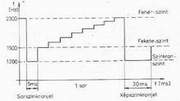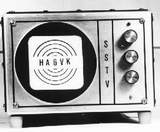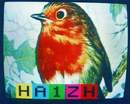|

One line of an SSTV picture
|
The SSTV is an acronym, stands for Slow Scan TeleVision. This mode is
a thinband TV system, which was developed by a group of radio amateurs
led by Copthorne McDonald - VE1BFL - in 1958. The bandwidth of the system
at the picture resolution was choosen in mind of the SSB enabled radio
systems of current radio amateurs. Since the transmission of the motion
wasn't important, by reducing the scan speed of the normal TV pictures
the bandwidth lowering was reached. The 3MHz bandwidth TV sign turned
into 3 kHz, so it consumes less space as the well known FSTV system.
|

8 sec SSTV picture
|
The line and picture synchron sign has to be changed, this resulted in
the following. On 50Hz based areas the line sync is 16.66 Hz and the picture
sync is 0.139 Hz, on 60Hz areas the line is 15Hz and the picture is 0.125
Hz. So the picture time is 7.2 secunds and 8 secunds. The bandwidth of
the sign is max. 2.5 kHz. The pictures size is 1:1, the scanning process
of the image is done from left to right and from above to the bottom.
In one row there is 128 pixels, and one picture contains 120 lines. The
synchron sign is 1200 Hz, the black point is 1500 Hz, the white point
is 2300 Hz. These are the properties of the 8 sec black and white SSTV
picture.
|

SSTV monitor /HA6VK/
|
The sign received by the SSB receiver is a sound frequency converted
from videosign and it is sent to a monitor, which has a special part called
long backlighting cathod ray tube, which helps in storing the picture.
This was able to still show the first lines after the picture was drawn
on the screen. The amount of time the picture was stored depended on the
backlighting effect of the tube. This is how they solved the storing of
pixels for the picture time. The monitor was built using electron tubes,
later transistors and integrated circuits.
|

SSTV camera /HA1ZH/
|
The scanning of the image was done by slow scan camera, sampling camera
and flying spot scanner. Mechanical picture scanner was used too. By mixing
the line and picture frequency to the video sign the SSTV sign resulted.
In this way the picture sign connected to the SSB transmitter's microphon
input could be transmitted.
|

Digital SSTV converter for 8-96 sec
/HA1ZH/
|
For the better and finer image resolution they increased the picture
time and increased pixel number transmitted in one line. Soon we were
able to work in 16, 32, 36 sec black and white pictures. The equipements
were made in analog systems by radio amateurs and companies. The better
picture quality, storage, better scanning was enabled by the digital technology.
The next step was the development of the so called "Digital Converters".
The analog SSTV signs were converted to digital with the required circuits,
and then it was stored. The required transformations were applied which
was needed in further processing the image, and it was read from the memory,
converted to analog signs, and displayed on an FSTV monitor. The camera
produced analog sign was digitalized in the same way, stored in memory,
and sent to the microphone input of the SSB transmitter.
|

LM9000C digital SSTV converter
/HA1ZH/
|
The color picture transmission was enabled by the digital converters.
One color image occupied three memory. One for the red R, green G, blue
B. The picture is read by lines and pictures, we call it line or picture
selecting system. For receive a small sized TV is enough, with some minor
modification. For sending a color or black and white camera was used,
with latter color filter had to be applied. The picture time of the color
ones were three times as much as the black and white ones: 24, 48, 72,
96 sec.
|

SSTV picture byLM 9000C converter in mode Martin 1
|
For the correction of noise caused picture modifications, information
loss, color errors, and for higher resolution new SSTV modes started to
develop. The image size ratio was 4:3. The pixels per lines and the number
of lines per picture was increased to 256. The system became free run
synchornized, this allows the automatic correction of synchron loss. Some
new modes that are used ever since: Martin, Scottie, ATV.
In Hungary the first SSTV article was released in 1972 by HA7RH. He described
the features of this mode, that was unknown for lots of radio amateurs.
A lot of good articles were released in the Radiotechnika magazine, ranging
from the simple analog to the advanced digital converters.
Many thanks to †HA7LF and †HA6VK amateur friends, who helped
a lot in the progress of educating radio amatuers and there are so many
of them on the radio bands.
The radio amateur bands are very narrow, but within this an even thinner
band was marked for SSTV mode. The general frequencies are: 3730
kHz, 7040 kHz, 14230 kHz, 14233 kHz, 21340 kHz and 28680 kHz and on
2 meters 144500 kHz +/- 5kHz.
Contests are held in this mode too, for example: in March the DL GARTG,
the USA IVCA world wide contest, in May OZ, in August the JA JASTA contest.
The exact date for these events can be found on the internet at the releated
country's SSTV news.
The SSTV transmission cannot only be done with above mentioned equipement,
there are quite a few computer based application exist that allow the
use of this mode. There is no need to build complicated equipements to
exchange pictures with other stations. From the available programs the
user can choose the one that he likes the best. Of course some is hardware
dependent, but the currently available computers don't cause a problem.
By mentioning the URL of some programs I hope I can help my radio amatuer
friends who decided to try this mode of communication. It is a great pleasure
for those who haven't tried this mode yet.
SSTV programs can be downloaded from the following URLs:
Help files and resources are available at the download pages, or within
the application.
I guess this is what fits into a nutshell, but if I can help in anything
please contact me by email and I happily answer all questions.
Thanks for reading!
------------ ------------ HA1ZH Zoli
------------ HA1ZH Zoli
|

